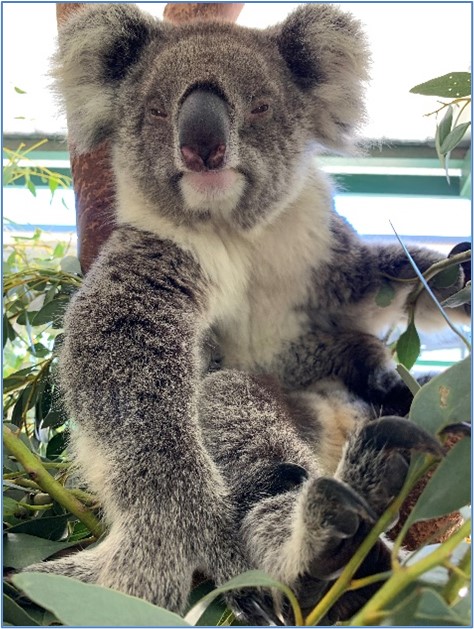
Animal Groups Express Concern Over Aerial Shooting of Hundreds of Koalas in Australia

Photo by Jennifer Skiff, director of international programs for the Center for a Humane Economy
Center for a Humane Economy, others urge non-lethal alternatives for managing post-fire wildlife challenges in Victoria
WASHINGTON, D.C. , DC, UNITED STATES, April 23, 2025 /EINPresswire.com/ -- The Center for a Humane Economy and other wildlife advocacy groups are expressing strong concern about the Victorian government’s recent aerial culling of koalas in Budj Bim National Park. The decision, made after bushfires swept through more than 5,000 acres of eucalyptus forest, has prompted calls for a reassessment of wildlife response strategies in fire-affected regions.
State officials have stated that the operation was conducted out of concern for koalas whose food sources may have been destroyed by the fires, potentially leaving animals injured, starving, or suffering.
“The state and national governments promote koalas and kangaroos as wildlife icons in their marketing campaigns to draw tourists, but they treat the lives of these animals as expendable and as unworthy of the most basic methods of humane care and management,” said Wayne Pacelle, president of the Center for a Humane Economy. “The decision-makers in Victoria simply do not understand the value of animal welfare, and their aerial gunning assault against the arboreal and slow-moving koalas is a disgrace.”
Pacelle tied the atrocity to the mass slaying of kangaroos, killed mainly for their skins for export for athletic shoes and some other products. Kangaroos and koalas are native species that evolved on the Australian landscape over many millions of years, while humans have been on the continent for just 65,000 years.
“Whether they shoot kangaroos from trucks or koalas from aircraft, it’s ruthless treatment,” he said. “If I’m a koala or a kangaroo, let me take my chances even in the wake of fires or drought rather than deal with the henchmen sent out to slaughter the adults and orphan the young. These animals evolved in the presence of major perturbations in their environment.”
“This tragedy didn’t happen in isolation. It’s the result of decades of mismanagement by DEECA,” said a statement by the Koala Alliance. “Accepting these killings as ‘necessary’ sets a dangerous precedent — one that normalizes cruelty under the guise of welfare, carried out by a government with a long history of secrecy around koala management.”
Advocates say the government’s explanation doesn’t hold up, especially since koalas in parts of Australia are listed as endangered. They point to existing koala hospitals and rehabilitation centers that could have taken in the injured animals.
Conservationist Peter Hylands of Creative Cowboy Films emphasized the lack of precision in such aerial operations. “It is not possible to assess the health and condition of a koala, particularly a koala with a joey, from a helicopter,” he said. “Yet they were shot down — uninjured animals included — under the false pretense of mercy.”
Some critics argue the killings may be linked to efforts to keep koalas away from nearby commercial eucalyptus plantations, where they risk being labeled as pests by private landowners.
“The Budj Bim koala massacre is the latest disgrace from a government that simply does not value wildlife,” said Alyssa Wormald, president of the Victorian Kangaroo Alliance. “They are already overseeing the systematic slaughter of kangaroos — this is part of a broader ecocidal agenda.”
"Hundreds of koalas were shot from helicopters — their joeys fallen from trees and left clinging to their dead or dying mothers," said Jennifer Skiff, director of international programs for the Center for a Humane Economy and a long-time resident of Perth. “After the fires of 2019-20, wildlife hospitals were built, and emergency response protocols were put in place. And yet here we are — not failing due to lack of resources or knowledge, but due to a lack of moral compass by those charged with managing wildlife. This is bureaucratic apathy and a betrayal of the global goodwill that helped Australia build the systems meant to protect wildlife after fires."
Despite widespread outcry and the availability of rescue resources, government officials have indicated that more koala aerial gunning may be conducted.
ABOUT
The Center for a Humane Economy is a Washington, D.C.-based 501(c)(3) whose mission is to help animals by helping forge a more humane economic order. The first organization of its kind in the animal protection movement, the Center encourages businesses to honor their social responsibilities in a culture where consumers, investors, and other key stakeholders abhor cruelty and the degradation of the environment and embrace innovation as a means of eliminating both. The Center believes helping animals helps us all. X: @TheHumaneCenter
Wayne Pacelle
Animal Wellness Action
+1 443-865-3600
email us here
Visit us on social media:
Instagram
Facebook
YouTube
Distribution channels: Agriculture, Farming & Forestry Industry, Culture, Society & Lifestyle, Environment, Natural Disasters, Science
Legal Disclaimer:
EIN Presswire provides this news content "as is" without warranty of any kind. We do not accept any responsibility or liability for the accuracy, content, images, videos, licenses, completeness, legality, or reliability of the information contained in this article. If you have any complaints or copyright issues related to this article, kindly contact the author above.
Submit your press release